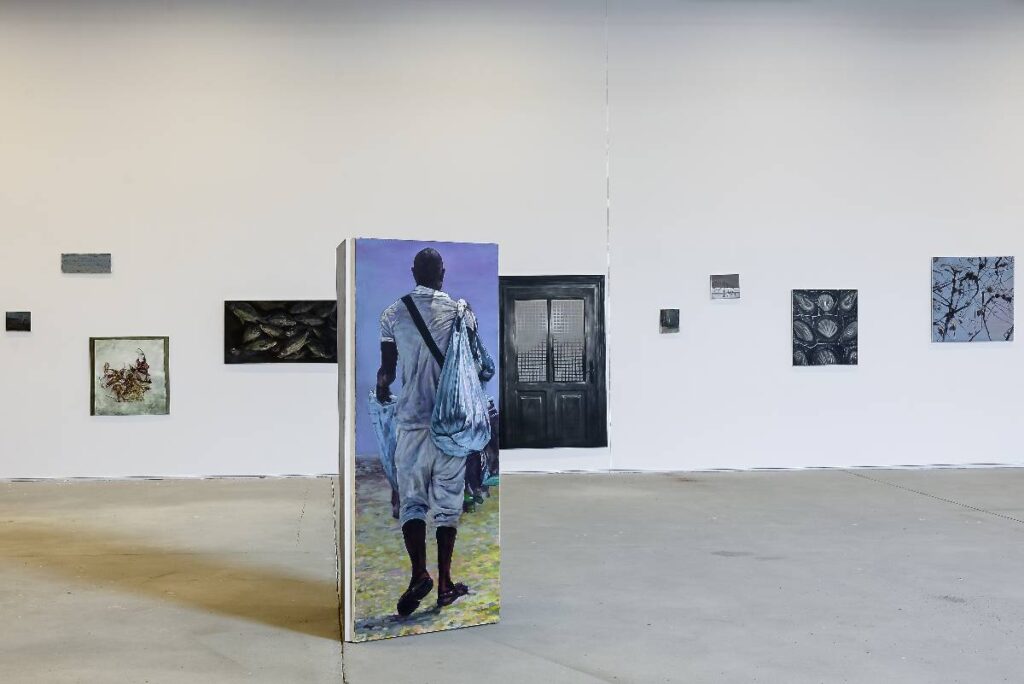Still Life Made Of Living Things
22 September – 20 October 2017
Artist: Istvan Betuker
Location: Sector 1 Gallery
The paintings of Istvan Betuker are „still life made of living things” (with the words of Jean-François Lyotard regarding the images of the French painter Jacques Monory). They are frozen moments from a wider narrative whose meaning will always remain inaccessible. These detached and isolated sequences form a wider group of images reunited by a certain feeling rather than an overall theme – it is an extended series refined during the last several years of Betuker’s pictorial production.
His figurative paintings are unheimlich and it is not at all a novelty to remark– it has been an already commented and appreciated feature – something lively-dead or deadly-alive, diffusely phantasmatical, contagious and morbid. Previous exhibitions have already pointed out the uncanny dimension of Istvan Betuker’s painting as a whole (the unfamiliarity of the familiar, the ”already-known” which is repressed and then comes back disguised as ”strange”). This peculiarity of his imagery manifests mainly through its chromatic filter – a device by means of which the pictorial compositions migrate towards violet shades – just as old or imperfect photography slides used in art history classes when teaching the history of painting turn to red, candidly distorting visual art.
His figurative paintings are unheimlich and it is not at all a novelty to remark– it has been an already commented and appreciated feature – something lively-dead or deadly-alive, diffusely phantasmatical, contagious and morbid. Previous exhibitions have already pointed out the uncanny dimension of Istvan Betuker’s painting as a whole (the unfamiliarity of the familiar, the ”already-known” which is repressed and then comes back disguised as ”strange”). This peculiarity of his imagery manifests mainly through its chromatic filter – a device by means of which the pictorial compositions migrate towards violet shades – just as old or imperfect photography slides used in art history classes when teaching the history of painting turn to red, candidly distorting visual art.
Betuker’s painterly images are just left there to – chromatically – float, immersed as they are in a viscous, hollow bath of inorganic chemistry within the space frame given by a certain visual ”arrest”. The inhabitants of this imagery navigate a diffused and agglutinant field of violet not unsimilar to a self-secreted fluid that has the function of a visual filter: it maintains the structure and control over a phantasmatical dynamics which would otherwise threaten to engulf the image. There is something reserved and kept unsaid in all these paintings, controlled and contained by the means of crop and fame techniques, always keeping the temperature and climate of the images at bay.
There isn’t ”before” nor ”after”, as much as there isn’t narration nor ”here and there” clearly defined in Betuker’s imagery. The depicted human characters in this painting swim in color, they twist, raise a hand, seem to move a leg, they bend their back, close their eyes; and these pseudo-actions have no overall foreseeable meaning attached to them. The specific tailoring of these loose compositions steal the device of the cinematic slow motion, evolving gradually in a hazy, murky visual fog, a general blurredness indebted, in terms of “technique”, to Betuker’s astonishing level of pictorial mastering.
As a consequence of the violaceous airflow exuded by the space, even though everything is so well painted (as a matter of fact, precisely because of it, as I was saying), it is as if you don’t perceive the image properly; it is as if not the image per se but rather the action, the event, the situation in which the humans pedal slowly is blurred. The actual facts in Betuker’s painting are completely blurred; one does not properly understand what is taking place there (and, given the literature on Gerhardt Richter’s painting, this remains one of the most astute questions regarding painting that relates to photography: if there are such things as blurred photographies, would it be also possible to paint blurred paintings?)
However strongly pictorial they may be, the human characters in Betuker’s painting are still unclear, ambiguous and fuzzy. Whomever they might be from one portrait to another, they all retain something adolescent and hybrid, reminding us of young adult characters that have been injected with a slowness-inducing substance, a permanent delay sticking them in one place. Nothing can touch or move them at all as they are perfectly contained by a pictorial stillness that operates like a peculiar chromatic disorder, an undocumented personal autistic condition. In a famous essay, the art historian Benjamin Buchloh drew attention to the inclusion of ambiguous children and adolescents in the imagery of what was called la retour à l’ordre (“the return to order”) that occurred in European painting during the `20s, a pictorial device symbolically indicative of the painting’s regression towards itself, a quasi-pathological withdrawal inside its own condition taking place in a historical and political context which was, by all means, heavily loaded and morbid.
Betuker’s drawing is firm, his color is refined, almost extravagant. As a matter of fact, under this respect Betuker Istvan’s painting has a special place both in the wider frame of the Romanian tradition of painting and within the context of the recent “return to painting” that took place throughout the previous decade in Romanian art. Playing more or less on one and the same violet spectrum – even though it is not, Betuker Istvan’s painting seems monochrome.
There isn’t ”before” nor ”after”, as much as there isn’t narration nor ”here and there” clearly defined in Betuker’s imagery. The depicted human characters in this painting swim in color, they twist, raise a hand, seem to move a leg, they bend their back, close their eyes; and these pseudo-actions have no overall foreseeable meaning attached to them. The specific tailoring of these loose compositions steal the device of the cinematic slow motion, evolving gradually in a hazy, murky visual fog, a general blurredness indebted, in terms of “technique”, to Betuker’s astonishing level of pictorial mastering.
As a consequence of the violaceous airflow exuded by the space, even though everything is so well painted (as a matter of fact, precisely because of it, as I was saying), it is as if you don’t perceive the image properly; it is as if not the image per se but rather the action, the event, the situation in which the humans pedal slowly is blurred. The actual facts in Betuker’s painting are completely blurred; one does not properly understand what is taking place there (and, given the literature on Gerhardt Richter’s painting, this remains one of the most astute questions regarding painting that relates to photography: if there are such things as blurred photographies, would it be also possible to paint blurred paintings?)
However strongly pictorial they may be, the human characters in Betuker’s painting are still unclear, ambiguous and fuzzy. Whomever they might be from one portrait to another, they all retain something adolescent and hybrid, reminding us of young adult characters that have been injected with a slowness-inducing substance, a permanent delay sticking them in one place. Nothing can touch or move them at all as they are perfectly contained by a pictorial stillness that operates like a peculiar chromatic disorder, an undocumented personal autistic condition. In a famous essay, the art historian Benjamin Buchloh drew attention to the inclusion of ambiguous children and adolescents in the imagery of what was called la retour à l’ordre (“the return to order”) that occurred in European painting during the `20s, a pictorial device symbolically indicative of the painting’s regression towards itself, a quasi-pathological withdrawal inside its own condition taking place in a historical and political context which was, by all means, heavily loaded and morbid.
Betuker’s drawing is firm, his color is refined, almost extravagant. As a matter of fact, under this respect Betuker Istvan’s painting has a special place both in the wider frame of the Romanian tradition of painting and within the context of the recent “return to painting” that took place throughout the previous decade in Romanian art. Playing more or less on one and the same violet spectrum – even though it is not, Betuker Istvan’s painting seems monochrome.
Looking for more?
Address
Băiculești 29 Street, District 1, 013193, Bucharest, Romania
Opening Hours
Tuesday – Saturday, 2 – 7 PM
Sunday – Monday, by appointment only
Newsletter
Sign up to receive the latest news on the gallery’s artists
Sector 1 Gallery © 2023. All Rights Reserved.
Privacy Policy

